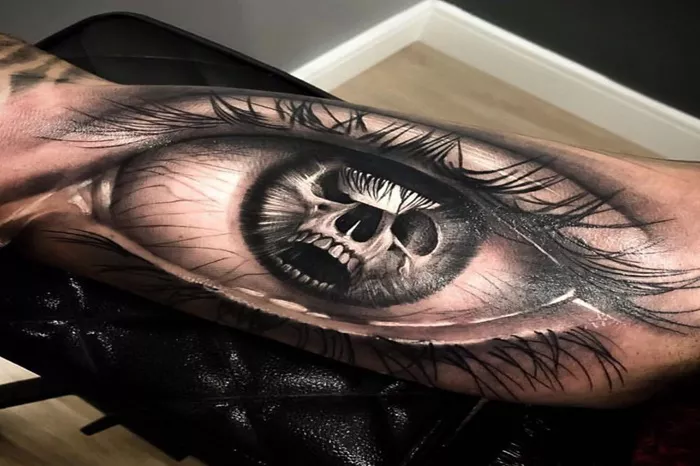Tattoos have long been a form of artistic expression, serving as a canvas for personal stories, beliefs, and aesthetics. Among the myriad of tattoo themes, one that stands out for its striking imagery and deep symbolism is that of demons. These infernal beings, often associated with darkness, temptation, and the supernatural, have fascinated and terrified humanity for centuries. In the realm of tattoo art, demon designs offer a unique opportunity for individuals to explore their darker sides, confront inner fears, or simply embrace the allure of the forbidden. In this comprehensive guide, we delve into the world of demon tattoo designs, exploring their history, symbolism, popular motifs, placement options, and more.
I. The History and Symbolism of Demon Tattoos
The fascination with demons and other supernatural entities can be traced back through various cultures and mythologies. In ancient civilizations such as Mesopotamia, Egypt, and Greece, demons were often depicted as malevolent spirits or gods of the underworld, wielding power over life and death. These early representations laid the foundation for the rich tapestry of demon lore that would evolve over the centuries.
II. Popular Motifs in Demon Tattoo Designs
Demon tattoos encompass a wide range of motifs, each with its own unique symbolism and aesthetic appeal. From traditional depictions inspired by folklore and religious texts to contemporary interpretations influenced by pop culture and fantasy art, there are countless options for those seeking to adorn their bodies with infernal imagery.
Demon tattoos encompass a vast array of motifs, drawing inspiration from folklore, mythology, religious texts, and contemporary art. Some of the most popular motifs include:
Classic Demons: Traditional demon designs often feature horned creatures with grotesque features, reminiscent of medieval depictions found in religious texts and artwork. These demons may be portrayed wielding weapons, surrounded by flames, or engaged in battle with angels or other supernatural beings.
Japanese Oni: In Japanese folklore, Oni are malevolent spirits often depicted as fearsome ogres with sharp claws, wild hair, and horns protruding from their heads. Oni tattoos symbolize protection against evil spirits and are commonly adorned with vibrant colors and intricate designs.
Satanic Imagery: Symbols associated with Satanism, such as pentagrams, inverted crosses, and sigils, are popular motifs in demon tattoos. These designs often evoke themes of rebellion, defiance, and the embrace of darkness.
Fantasy Creatures: With the rise of fantasy literature and role-playing games, demon tattoos inspired by fictional creatures have gained popularity. From the demonic denizens of “Dungeons & Dragons” to the infernal beings of “World of Warcraft,” these designs offer a blend of imagination and artistic interpretation.
Gothic Aesthetics: Gothic imagery, characterized by macabre themes, Victorian-era fashion, and romanticized depictions of death, often features prominently in demon tattoos. These designs may incorporate elements such as skulls, bats, ravens, and dark roses, creating a hauntingly beautiful aesthetic.
III. The Art of Demon Tattoo Placement
Choosing the right placement for a demon tattoo is crucial for achieving the desired impact and aesthetic balance. While some may opt for highly visible areas such as the arms, chest, or back, others may prefer more discreet locations like the ribs, thighs, or ankles. Additionally, the size and intricacy of the design will often dictate the ideal placement, with larger pieces typically requiring more spacious canvas areas.
IV. Demon Tattoos in Pop Culture and Media
In recent decades, demons have become ubiquitous figures in popular culture, appearing in literature, film, television, and video games. From iconic characters like Lucifer Morningstar in “Lucifer” to the demonic creatures of “Supernatural,” these representations have fueled the mainstream appeal of demon tattoos among enthusiasts of all ages.
V. The Spiritual and Metaphysical Significance of Demon Tattoos
For some individuals, demon tattoos hold deep spiritual or metaphysical significance, serving as symbols of personal beliefs, inner struggles, or transformative experiences. Whether viewed as protectors against malevolent forces or as manifestations of inner demons to be confronted and overcome, these tattoos can carry profound meaning for those who choose to adorn themselves with them.
VI. Finding the Right Tattoo Artist for Your Demon Design
When it comes to immortalizing a demon design on your skin, choosing the right tattoo artist is paramount. Look for professionals with experience in creating intricate and detailed pieces, as well as those who demonstrate a keen understanding of demon symbolism and aesthetics. Additionally, don’t hesitate to ask for portfolio samples and client testimonials to ensure that the artist’s style aligns with your vision.
VII. Caring for Your Demon Tattoo
Once you’ve received your demon tattoo, proper aftercare is essential to ensure optimal healing and long-term vibrancy. Follow your tattoo artist’s instructions diligently, keeping the tattoo clean, moisturized, and protected from excessive sunlight and physical trauma. With the right care regimen, your demon tattoo will continue to be a source of pride and inspiration for years to come.
VIII. Conclusion: Embracing the Darkness with Demon Tattoos
In conclusion, demon tattoos offer a captivating glimpse into the darker aspects of human nature, inviting individuals to explore themes of temptation, rebellion, and the supernatural. Whether drawn to these designs for their aesthetic appeal, symbolic significance, or spiritual resonance, those who choose to adorn themselves with demon tattoos join a rich tradition of artistic expression that spans cultures and centuries. So, embrace the darkness, confront your inner demons, and let your tattoo serve as a testament to the complexity and depth of the human experience.

